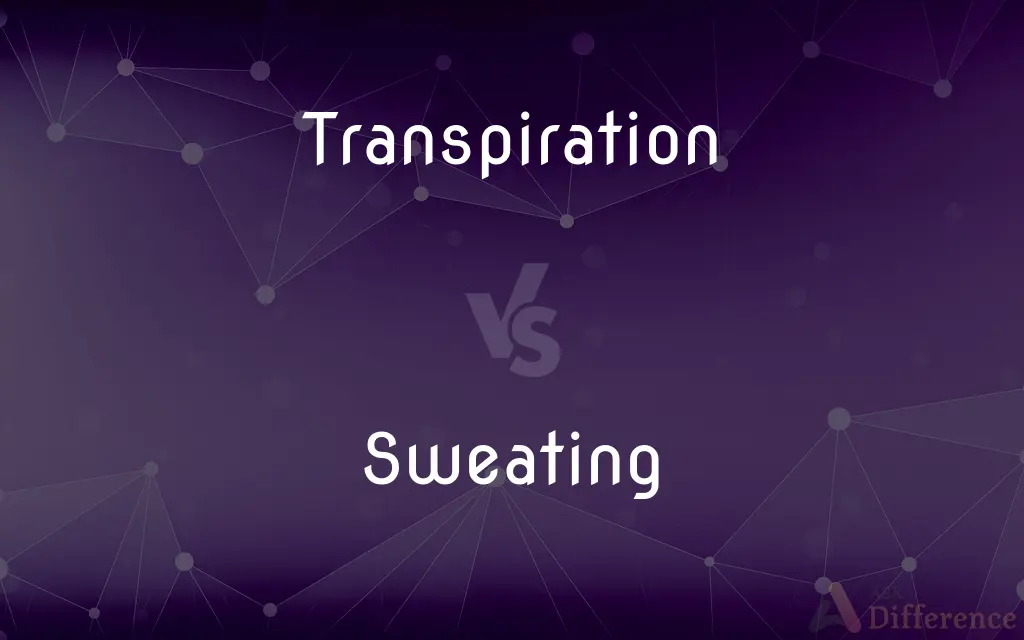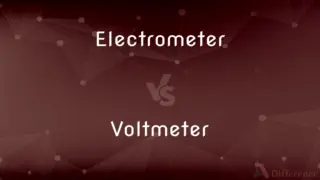Transpiration vs. Sweating — What's the Difference?
By Tayyaba Rehman — Updated on September 27, 2023
Transpiration is the process of water movement through plants and its evaporation from aerial parts, while sweating is the release of liquid from the body's sweat glands. Both are cooling mechanisms but for plants and humans respectively.

Difference Between Transpiration and Sweating
Table of Contents
ADVERTISEMENT
Key Differences
Transpiration is a crucial process in plants, involving the movement and evaporation of water from their aerial parts, primarily the leaves. In contrast, sweating is a physiological process in humans and some animals where liquid is released from sweat glands, usually as a response to heat or stress. Transpiration aids plants in nutrient transport, while sweating helps regulate body temperature.
The mechanism of transpiration primarily takes place through tiny openings in plant leaves known as stomata. As water is drawn up from the roots, it moves to these stomata and is released into the atmosphere as water vapor. Conversely, sweating involves specialized sweat glands in the skin that excrete a mixture of water, salts, and other compounds when activated.
While both transpiration and sweating result in the loss of water, their purposes differ significantly. Transpiration plays a role in photosynthesis and helps create a negative pressure that facilitates the uptake of water and nutrients from the soil. Sweating, on the other hand, is a cooling mechanism that maintains homeostasis in the body by preventing overheating.
Environmental factors influence both processes. Transpiration rates can increase with higher light intensities, temperatures, and wind speeds, while factors such as humidity can reduce it. Sweating rates in humans can be influenced by physical activity, ambient temperature, and individual metabolic rates.
In essence, transpiration is the plant world's counterpart to the animal world's sweating. While both involve the release of water, they serve different functions in their respective organisms and are responses to different stimuli and needs.
ADVERTISEMENT
Comparison Chart
Definition
Evaporation of water from plant parts
Excretion of liquid from sweat glands
Purpose
Aids in photosynthesis and nutrient uptake
Regulates body temperature
Mechanism
Through stomata in leaves
Via sweat glands in the skin
Influencing Factors
Light intensity, temperature, wind, humidity
Ambient temperature, physical activity, humidity
Composition
Mostly pure water
Water, salts, and other compounds
Compare with Definitions
Transpiration
Process assisting in plant nutrient uptake and transport.
Transpiration drives the movement of minerals from the soil.
Sweating
Release of fluid from sweat glands.
Sweating helps in expelling toxins from the body.
Transpiration
Plant mechanism linked to cooling and photosynthesis.
Transpiration is essential for photosynthesis efficiency.
Sweating
Physiological response to heat or stress.
She was sweating profusely under the scorching sun.
Transpiration
Evaporation of water from plant surfaces.
Transpiration rates increase during sunny days.
Sweating
Excretion containing water, salts, and other compounds.
Sweating can lead to dehydration if not replenished.
Transpiration
Loss of water vapor through stomata.
The stomata control transpiration in leaves.
Sweating
To excrete perspiration through the pores in the skin; perspire.
Transpiration
Continuous movement of water from roots to leaves.
Transpiration ensures water reaches all parts of the plant.
Sweating
To exude in droplets, as moisture from certain cheeses or sap from a tree.
Transpiration
Transpiration is the process of water movement through a plant and its evaporation from aerial parts, such as leaves, stems and flowers. Water is necessary for plants but only a small amount of water taken up by the roots is used for growth and metabolism.
Sweating
To collect moisture in small drops from the air, as a cold water pipe.
Transpiration
The act or process of transpiring, especially through the stomata of plant tissue or the pores of the skin.
Sweating
To release moisture, as hay in the swath.
Transpiration
(botany) The loss of water by evaporation in terrestrial plants, especially through the stomata; accompanied by a corresponding uptake from the roots.
Sweating
To ferment, as tobacco during curing.
Transpiration
(physiology) The process of giving off water vapour through the skin or mucous membranes.
Sweating
(Informal) To work long and hard
Sweated over his term paper.
Transpiration
The passage of gases through fine tubes.
Sweating
(Informal) To fret or worry
Don't sweat over the bills.
Transpiration
The act or process of transpiring or excreting in the form of vapor; exhalation, as through the skin or other membranes of the body; as, pulmonary transpiration, or the excretion of aqueous vapor from the lungs. Perspiration is a form of transpiration.
Sweating
To excrete (moisture) through a porous surface, such as the skin.
Transpiration
The evaporation of water, or exhalation of aqueous vapor, from cells and masses of tissue.
Sweating
To excrete (wastes) in perspiration
Sweated out the toxins in the steam room.
Transpiration
The passing of gases through fine tubes, porous substances, or the like; as, transpiration through membranes.
Sweating
To have (moisture) condense in small drops on a surface.
Transpiration
The passage of gases through fine tubes because of differences in pressure or temperature
Sweating
To cause to perspire, as by drugs, heat, or strenuous exercise
Running for the train got me sweated up.
Transpiration
The process of givng off or exhaling water vapor through the skin or mucous membranes
Sweating
To make damp or wet with perspiration
His shirt was sweated.
Transpiration
The emission of water vapor from the leaves of plants
Sweating
To cause to work excessively; overwork.
Sweating
To overwork and underpay (employees).
Sweating
To interrogate (someone) under duress
Sweated the suspected spy for hours.
Sweating
To extract (information) from someone under duress
The police sweated the information out of the suspect.
Sweating
(Metallurgy) To join (metal parts) by interposing cold solder and then heating.
Sweating
To steam (vegetables or other food).
Sweating
(Informal) To fret or worry about
Don't sweat the details.
Sweating
The colorless saline moisture excreted by the sweat glands; perspiration.
Sweating
Condensation of moisture in the form of droplets on a surface.
Sweating
The process of sweating.
Sweating
A condition or instance of sweating
Worked up a sweat raking leaves.
Sweating
Strenuous labor or exertion
It took a lot of sweat to move the piano.
Sweating
A run given to a horse as exercise before a race.
Sweating
(Informal) An anxious, fretful condition
Got myself in a sweat over the deadline.
Sweating
A sweatsuit.
Sweating
Sweatpants.
Sweating
The production and evaporation of a watery fluid called sweat that is excreted by the sweat glands in the skin of mammals.
Sweating
(botany) Mucilage, especially of cocoa.
Sweating
(cooking) The gentle heating of vegetables in oil or butter.
Sweating
Present participle of sweat
Sweating
Giving off sweat.
A sweating man stepped out of the sauna, wrapping himself in a towel.
Sweating
The process of the sweat glands of the skin secreting a salty fluid;
Perspiration is a homeostatic process
Sweating
Being wet with perspiration;
The perspiring runners
His sweating face
Sweaty clothes
Sweating
Body's method to regulate temperature.
He started sweating after the intense workout.
Sweating
Natural cooling mechanism of the body.
Sweating is the body's way of staying cool in hot weather.
Common Curiosities
Can transpiration occur at night?
Yes, but at a much-reduced rate since stomata are usually closed.
What is transpiration in plants?
Transpiration is the process of water movement through plants and its evaporation from aerial parts.
Why is transpiration essential for plants?
Transpiration aids in photosynthesis, nutrient transport, and maintains water and nutrient flow from roots to shoots.
What triggers sweating in humans?
Heat, physical activity, stress, and certain emotions can induce sweating.
How do plants control transpiration?
Primarily through the opening and closing of stomata, regulated by guard cells.
How does sweating differ from transpiration?
Sweating is the release of liquid from the body's sweat glands, mainly to regulate temperature, while transpiration is water evaporation in plants.
What is the primary component of sweat?
Water, but it also contains salts and other compounds.
Share Your Discovery

Previous Comparison
Claim vs. Argue
Next Comparison
Electrometer vs. VoltmeterAuthor Spotlight
Written by
Tayyaba RehmanTayyaba Rehman is a distinguished writer, currently serving as a primary contributor to askdifference.com. As a researcher in semantics and etymology, Tayyaba's passion for the complexity of languages and their distinctions has found a perfect home on the platform. Tayyaba delves into the intricacies of language, distinguishing between commonly confused words and phrases, thereby providing clarity for readers worldwide.
















































